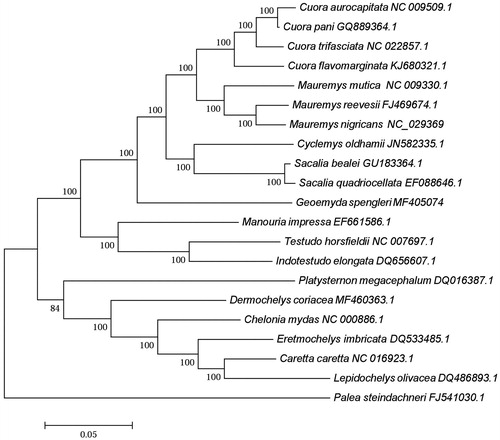Abstract
In this study, we determined the entire mitochondrial genome of Geoemyda spengleri. The complete mitogenome sequence was 17,448 bp in length, containing 13 protein-coding genes (PCGs), 22 transfer RNA (tRNA) genes, and 2 ribosomal RNA (rRNA) genes; it also featured a control region (D-Loop). The overall nucleotide composition was as follows: A, 33.7%; T, 27.6%; C, 25.6%; and G, 13.1%, with a total A + T content of 61.3%. The phylogenetic analysis demonstrated a close relationship between G. spengleri, Sacalia quadriocellata, Sacalia bealei, Cyclemys oldhamii, and other species in Geoemydidae.
Black-breasted leaf turtle (Geoemyda spengleri) belongs to Order Testudines, Family Geoemydidae (Cai et al. Citation2015). It is an important reptilia distributed in Hunan, Guangdong, Guangxi, Hainan of China and parts of Viet Nam. Threatened by the levels of trade and scarcity of this species, G. spengleri has been listed in the national second-class national-protected wild animal which belongs to the Convention on International Trade in Endangered Species of Wild Fauna and Flora (CITES) in Appendix III (China). Many researchers hold different opinions on the classification status of this species (Shen et al. Citation1998; Cai et al. Citation2015; IUCN Red List of Threatened Species Citation2017). In this study, we report the complete mitochondrial genome of G. spengleri based on the Sanger sequencing data and compared it with those of 20 other species mitochondrial genomes available from the Testudines.
Tissue samples of G. spengleri were provided by Heilongjiang Province Museum, and the specimen of G. spengleri was stored in the amphibians and reptiles specimen room of Heilongjiang Province Museum. The total genomic DNA was extracted from the muscle of the specimen using Tissue DNA Extract kit (Tiangen Biotech Inc., Beijing, China) following the manufacturer’s protocol. The mitogenomes were amplified using eighteen primers, and PCR products were determined by the method of Sanger sequencing. The sequencing results were then assembled using the DNAman software package version 6.0.3 (Lynnon Biosoft, Vaudreuil, Canada). The transfer RNA (tRNA) genes were initially identified using the tRNAscan-SE version 1.21 program (Lowe and Eddy Citation1997) and they were then checked manually. The protein-coding genes (PCGs) and ribosomal RNA (rRNA) genes of the mitochondrial genomes were annotated using the MITOS Web server (Bernt et al. Citation2013).
The complete mitogenome sequence of G. spengleri was 17,448 bp in length and it was deposited in GenBank under accession number MH748151. The sequence contained 13 PCGs, 22 tRNA genes, 2 rRNA (12SrRNA and 16SrRNA) genes, an origin of replication on the light-strand (OL), and a control region (D-Loop). The overall base composition was as follows: A, 33.7%; T, 27.6%; C, 25.6%; and G, 13.1%, with an A + T bias (61.3%), which was similar to Sacalia bealei, Cuora aurocapitata, and other tortoises in Geoemydidae.
The phylogenetic tree was constructed with MEGA5.0 based on 20 complete mitochondrial genome sequences of Tesudines with Palea steindachneri as an outgroup (). The phylogenetic position of G. spengleri was clustered with tortoises in Geoemydidae, and G. spengleri formed a sister relationship with Cuora, Mauremys, Cyclemys, and Sacalia in the Geoemydidae family, with 100% bootstrap support values.
Acknowledgements
The authors thank anonymous reviewers for providing valuable comments on the manuscript.
Disclosure statement
The authors report no declaration of interest. The authors alone are responsible for the content and writing of this article.
Additional information
Funding
References
- Bernt M, Donath A, Jühling F, Externbrink F, Florentz C, Fritzsch G, Pütz J, Middendorf M, Stadler PF. 2013. MITOS: improved de novo metazoan mitochondrial genome annotation. Mol Phylogent Evol. 69:313–319. doi:10.1016/j.ympev.2012.08.023
- Cai B, Wang Y, Chen Y, Li J. 2015. A revised taxonomy for Chinese reptiles. Biodivers Sci. 23:365–382.
- IUCN Red List of Threatened Species version 2017-2. 2017. [accessed 2018 Sep 23]. www.iucnredlist. org.
- Lowe TM, Eddy SR. 1997. tRNAscan-SE: a program for improved detection of transfer RNA genes in. Nucleic Acids Res. 25(5):955–964.
- Shen Y, Mo X, Deng X. 1998. Testudinata in Hunan province. Chin J Zool. 1:15–18.

